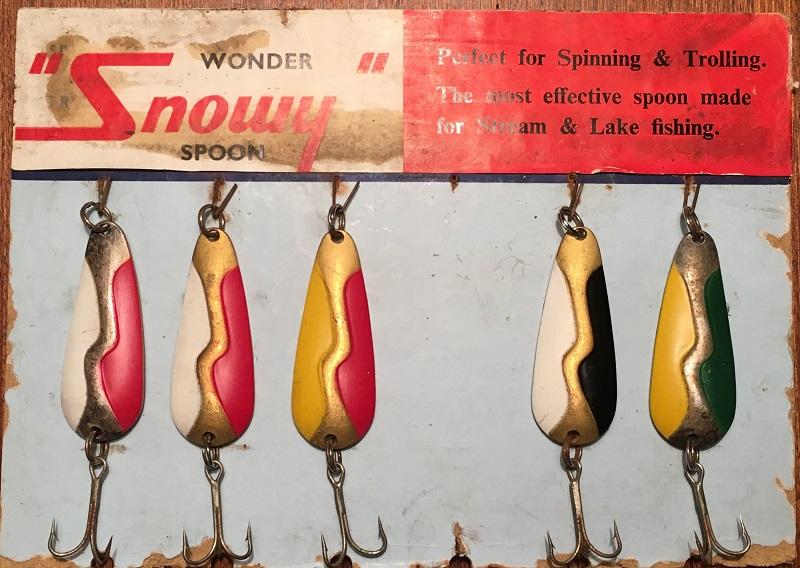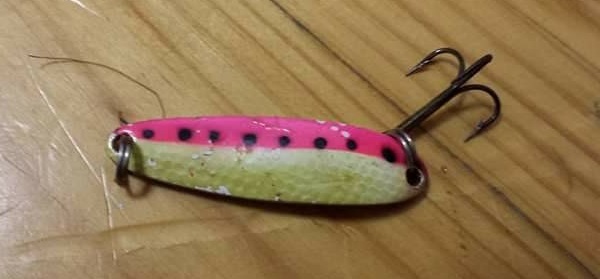Wonder Lures - VIC:
Wonder Lures has been around since the 1950s and was started by John Nowack (snr), a US serviceman who married a local girl and settled in Melbourne after the war. Wonder Fishing Tackle Company were situated in East Brighton, Melbourne. The Nowack family still makes metal lures, now on the Gold Coast under the Javelin Lure Co. brand. His son Peter took over the business and many of the older shapes like the wobbler and Toby were re-released by John Nowack Jnr under the Laser Lure brand back in the 1990's. Earlier Wonder lures are easily identifiable by the older pre metric markings which are in ounces as opposed to the metric grams. Essentially the entire Wonder range were copies of successful USA patterns and UK patterns such as the Hardy 'Imp', the Wonder Spoon which were similar to the earlier USA Daredevil spoons, the Wonder 'Lucky 7' was a Paul Bunyan copy. But they were accepted by the Australian lure anglers because they were effective and cheap - perfectly suited to the high speed spinning craze that arrived in the 1970's.


Shown is the rarely seen Wonder 'T' Spinner on an original dealer card with interesting graphics and spelling of Lake Eucumbene as 'Lake Eucombine'. Although there are only 5 left of the original dozen spinners these were rarely seen advertised but do appear in a 1964 advertisement. Marked on the blade, with a dark orange body, they are a medium sized spinner and were fitted with the sparkly orange flecked attractor on the split-ring with the treble.

Wonder 'Lucky 7' spinners on original trade card. This would date early to mid 1960's


(Left) This image was circulated as both an advertisement and in an older Lance Wedlick book which predated 1966.
Two examples of the Wonder Sparky showing makers markings are shown below


A number of the lures shown left faded in popularity over time. Models like the Colarado Spoon became superseded as new imported bladed lures were more readily available. The Lucky Seven Spinner which was an imitation of the original USA made Paul Bunyan Spoons with the spinning blade and feathered trebles soon lost favour. They were an old style lure. Models like the Wonder Wobbler and Wonder Spoon still sell today . . .

It was advertised in 1964 as available in 3 colour combinations however the photo above shows at least 5 different patterns. In 1966 the colours are listed as red/white, black/white and red/yellow. It looks like this could however refer to a 3 colour combinations to produce the gold centre strip and the silver centre strip as they are made from different metal so this would mean 6 colour combinations. There is also a green/yellow pattern shown which takes the possible combinations to 8 patterns but the jury is still undecided and there may be other patterns as well. The bottom of this dealer card lists the maker as the Wonder Fishing Tackle Co., Box 8, E. Brighton, VIC.
The Wonder 'Snowy' Spoon is another of the early models that was available by the early 1960's but probably earlier. This model only survived through the 1970's and not sure if it was available into the 1980's.
Note the Super Duper was available as a Wonder lure so rights to distribute and manufacture in Australia must have been granted by the original makers of the Super Duper although Wonder Lures was never stamped on the spinners. They were originally made by South Bend, USA. They were advertised with the Wonder model range by J. M Gillies Pty Ltd in the 1960's and 70's. They will bear the Patent Number 20025.



(Above) Early cardboard box for Wonder Wobbler in 1/4oz size. Note earlier pre-decimal price of 2/9. These boxes are becoming rarer to find especially for any model other than silver. There is also two boxes that have a different slogan on the side as shown below.


(Above) Early cardboard box for Wonder Wobbler in an alternative colour. Unsure if the timeline on this type of box but they are similar to the 2nd generation blue boxes.

(Above) Wonder Lure catalogue from 1964 Anglers Digest shows the full range that was available.
(Left) A 1966 J.M. Gillies advertisement showing some of the Wonder Lures range that they distributed. The address for J.M. Gillies Pty Ltd had changed within this time period from 122 Moray, Street, South Melbourne in 1964 to 148 Roden Street, West Melbourne by 1966.
(Below) A 1965 advertisement for part of the Wonder range.

(Below) Unmarked Wonder Wobbler in 1/4oz size which is reverse side of red lure in box. These are the earliest versions which predate the 1964 catalogue shown above.
(Above) Example of the Wonder 'Red Eye' which was a copy of the very popular Hofschnieder Red Eye from USA. It was available in silver and gold finish.

The first carded lures were released on a card that had the name of the lure printed below the Wonder Lure in orange/red at the top of the card with a fish logo at the bottom of the card.
(Below) The Wonder 'Hot Shot' which was a spinner to compete with imported products of the time such as Mitchell, Celta and Abu spinners. Easily identified and factory fitted with a single hook fly as opposed to a treble hook as shown in the earlier advertisements.



(Below) Examples of pre-metric Wonder Wobblers in 1/4 oz and 3/8 oz. Also shows different colour patterns that were available.

(Left) Examples of pre-metric Wonder Wobblers in 1/4 oz and 3/8 oz. Also shows different colour patterns that were available.
Another extremely popular model was the Wonder Spoon which over the years were punched from different types of metal. Unsure where these sit in the Wonder lures timeframe or whether they were made with various types of metal for the whole time.
The earliest models were originally presented in the cardboard boxes as shown here. Many of these are found with incorrect boxes as are the Wonder Wobbler model. In 1964 the Wonder Spoon was available in 8 colours which would have included a plain copper and plain silver spoon. There is evidence that some very early Wonder Spoons may be unstamped as they do turn up without the markings sometimes however there were other copies and manufacturers that did made a similar product





The Wonder Fish Seeker was at least available as early as 1964


During the spinning craze of the 1970's metal type slugs were extremely popular when targeting pelagic species such as tailor, kingfish and mackeral. They could be cast a long way on heavier lines and were used with a fast retrieve.
The two lures above are earlier examples of the Wonder 'Pilchard' in 60 and 100g weights.

The advertisement below appeared in the annual Tasmanian report for the North Western and South Western angling clubs for 1981. Spoon fishing has always been an effective method for catching all fish but especially trout.


Wonder 'Krocodile' - a later model showing markings


The advertisement below dates to the early 2000's. Opposite is 1991 and is useful in showing available colour range




Above is a Wondercast model - this was made by a New Zealand company and not an Australian made Wonder lure
The angling report below outlines the story of a 22lb trout being caught on a 1 1/2oz Wonder Wobbler to claim largest rod and reel caught trout in NSW as of 1969.
